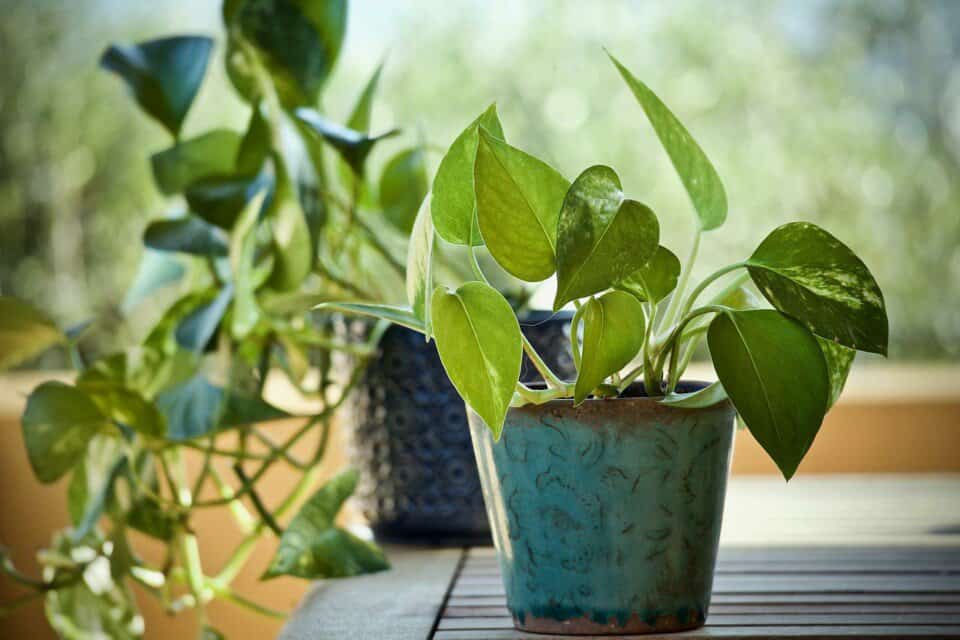Some links in the post are affiliate links and I get a commission from purchases made through some links found in the post.
Pothos is a genus of flowering plants in the family Araceae (tribe Potheae). It is native to China, the Indian Subcontinent, Australia, New Guinea, Southeast Asia, and various islands of the Pacific and Indian Oceans.
It is an evergreen climber with thick, waxy, green, heart-shape leaves, commonly grown in houses as a hanging plant.
Pothos can climb by growing aerial roots, and wild or cultivated plants grown outdoors can reach enormous heights using tall tress as support.
In addition, the leaves of outdoor plants grow many times larger than indoor plants. The plant can be easily propagated from cuttings and rarely grows any flowers.
Let’s now understand what aerial roots are and what is the need for growing aerial roots on a pothos
What are Aerial Roots?
 Aerial roots are those roots that develop from a location on a plant above the surface of the earth or water, as from a stem. They are roots which are fully or partially exposed to the air.
Aerial roots are those roots that develop from a location on a plant above the surface of the earth or water, as from a stem. They are roots which are fully or partially exposed to the air.
The basic purpose that they serve like any other plant roots is to absorb water and dissolved minerals, store food and keep the plant from falling over.
Furthermore, they eventually attach to something like trees, bark, or rocks, but they never become fully submerged in the soil.
They are a type of adventitious roots. These kinds of roots grow from the plant’s stem or leaf tissues but not from its root tissues.
Due to being exposed to the air, the roots are more likely to dry out and are usually found in wet environments such as tropical rainforests.
What is the Difference Between Underground Roots and Aerial Roots?
Underground roots as the name says are those which are beneath the surface of the earth. They are not exposed to the air or grow above the ground.
Roots are an organ that generally grows into the soil in developed plants that have adapted to terrestrial life, but rarely is found above the ground.
The underground roots have channels to transport nutrients and water to the stem and leaves. They also have channels that allow organic matter to be transported from the above-ground parts of the plant to the roots.
Underground roots usually spread out below the ground to be able to get water and other nutrients that are required by the different parts of the plant.
Why does my Pothos have Aerial Roots?
Pothos are growing aerial roots for several reasons. They provide additional water and nutrients to the plant and help the pothos to gain stability.
Aerial roots act as an anchor and attach themselves to poles or trellises. They also keep the growing roots from pulling out of the soil. Pothos’ aerial roots also provide oxygen to the plant.
This is one of the reasons the aerial roots climb up trees in tropical forests. They reach up out of the soggy ground and absorb oxygen.
Pothos that are growing in their natural environment like a rainforest, will absorb water and nutrients from rain with the help of their aerial roots.
At home, pothos’ aerial roots make it convenient to take cuttings and grow new plants by simply cutting a piece of stem below the roots.
Aerial roots are more likely to grow in humid conditions indoors or in a greenhouse outdoors.
A fact about aerial roots is that they grow towards light and so when they are in their natural habitat, they climb on trees because of their phototrophic behaviour.
Is it Okay to Cut Aerial Roots off a Pothos?
After knowing the reasons why your pothos grow aerial roots, it is safe to say that cutting part of the roots will not be harmful to your plant.
Your pothos won’t die from cutting off a couple of aerial roots, but if you can leave them uncut, all the better.
It will be okay if you trim the roots of the plant if they have grown too big. However, it is not necessary to cut the aerial roots of your pothos.
Cutting the roots can be helpful for your pothos in a few ways. It may promote healthier, lusher growth of foliage.
You can also cut off the dead roots as they do not provide any kind of benefit to your plant. If the aerial roots aren’t rotten or completely hollow, they continue growing and there is no need to cut them off.
How do you Water Aerial Roots on a Pothos?
As I said earlier, when the pothos is growing in its natural habitat or outdoors, it is usually able to absorb water from the air or the soil or it gets the water that it needs from rainfall.
But if your pothos are indoors then it would be a good idea to water the aerial roots or try to keep them misty.
In case you have taken cuttings of your pothos and are trying to grow new ones, you can simply put the cuttings of the stem and root in a jar of water.
Only make sure to change the water every three days. Wash the jar if you see green algae. Once new roots grow from your cuttings, you can shift them to a pot which is also known as propagating your pothos.
Should I Bury Aerial Roots?
 You can bury your aerial roots as it helps to control them if they are becoming difficult to handle. But for this to work, you will need your plant to be on the floor and have some contact with the earth.
You can bury your aerial roots as it helps to control them if they are becoming difficult to handle. But for this to work, you will need your plant to be on the floor and have some contact with the earth.
This is not possible if your pothos is hanging on a wall or is situated at a place above the ground.
You can begin by partially burying the roots in the ground or by burying the end of the aerial roots into the soil. These will then begin to develop themselves as normal roots.
If you then want to propagate the plant, you will only have to unearth these roots with a portion of branch and will have a new plant growing.
How do you Train Aerial Roots Pothos?
Training aerial roots of pothos is rather simple. Although naturally a pothos plant does not climb unless something is prompting them.
In nature, it is usually the search for light due to which the pothos tends to grow onto trees in the forest. So, if you want to train your pothos, there should be something prompting it to climb.
There are a few ways to prompt your pothos to grow. You can attach the aerial roots of your pothos to a support such as poles, bamboo canes, wires, or trellises.
Pothos aerial roots can also latch onto walls but doing so may damage your walls and leave marks on it so it’s better not to.
You can place a light source near your pothos and keep it on the side you want your pothos to grow. This will act almost like a stimulus for your aerial roots, and you will witness them growing in the direction of the light.
Aerial roots can be easier to handle and make your pothos look more aesthetic when they are trained.
How do you Repot a Pothos with Aerial Roots?
Repotting your pothos with aerial roots can be done in three steps. They are among the easiest plants to repot so you need not worry about it much.
To begin the process, you will first have to take out your pothos from their current location. This could be a pot or the ground.
Water the pothos a day or two before, or even 15-60 minutes before. The purpose is to let your roots absorb some water so when the time comes to take them out, they bend more easily.
Then gently pull out your plant, making sure than no stems break in the process. Have a look at the root ball of your pothos.
If it does not have too many roots showing along the outside, you can easily move on to the next step of replanting into a new pot with no further attention to the roots.
However, if the plant has lots of root’s circling around the outside of the root ball, then you should first help it out of the twirling shape. This can be done by placing it in a jar of water.
Make sure to select a pot which is bigger in size than the previous one in which you will be putting your pothos and that it has plenty of drainage holes.
Next place an inch or two of potting mix in the bottom of a clean pot and place your pothos plant upright in the new pot and add potting mix around the sides to fill in the gaps.
Only leave about 2 inches of space on top. Now give a good, deep water. It should be so that the water starts to run out the bottom. The water will make the soil settle, so add a little more to the top to compensate.
Your plant will then be successfully repotted along with its aerial roots.
You may also like: Why is my pothos cutting not rooting & how to fix it
How do you Help your Aerial Roots to Grow?
 Keeping your pothos in a warm room with relatively higher humidity will encourage its aerial roots to grow on the long stems of your plant.
Keeping your pothos in a warm room with relatively higher humidity will encourage its aerial roots to grow on the long stems of your plant.
Pothos seem to produce more aerial roots and an attempt to take advantage of the humid conditions. They’re trying to get as much moisture out of the atmosphere as possible.
Low light conditions can also be a factor which will encourage the aerial roots to grow. As the aerial roots do grow towards light, they tend to grow faster and longer in search of it.
Temperatures in the range of 70-90°F (21-32°C) will be perfect for your plant.
Your pothos will not do well in temperatures below 12°C and above 32°C and will most likely shows signs that it is not doing by either having unhealthy looking leaves or stunted growth.
Aerial roots are sensitive to water supply. Overwatering and underwatering the roots can both cause problems for it. If you overwater the roots there is chance of root rot as the roots tend to get suffocated.
Whereas, underwatering the pothos aerial root will moisture-stress your plant which will then result in them having stunted growth.
So, make sure to water your pothos aerial roots once the soil has dried out from the top few inches. Do not water it while the soil is still wet from the top nor let it go dry more than the top few inches.
Other than humidity, water and light, your roots will need soil which is rich in nutrients and fulfils the nutritional and mineral needs of your plant.
Can New Roots Grow from Aerial Roots?
Generally, you cannot just take cuttings or pieces of your aerial roots, place them in soil or water and expect them to grow.
This will not happen until you take a cutting which includes the stem with a node on it, a few leaves, and the aerial root.
Once you have a piece as the one described above, you can place it in water or soil and soon you will see new roots growing from your cutting of the pothos.
Why does my Pothos have so many Aerial Roots?
Pothos may sometimes grow a lot of aerial roots. There can be a couple of factors involved which result in your pothos growing so many aerial roots.
High humidity levels may promote the roots of your pothos to grow excessively. As the aerial roots try to absorb more and more moisture from the humid air, they tend to grow and increase in number.
Another reason could be the absence of light which is why your pothos are growing so many aerial roots. It is to get lighter and so the roots start to grow in the direction which they detect light from.
Your roots will also grow well and may be more than expected if they are growing in soil with optimum nutrients and are living in temperatures which are perfectly suitable for them.
Why is my Pothos Growing Aerial Roots but no Leaves?
Aerial roots will grow when they are getting the optimum conditions that were discussed above. Similarly, the pothos leaves also require certain conditions to thrive.
These are pretty much the same as those required by the aerial roots. They need water, light, and nutrients to be able to grow well.
Overwatering can be one of the major reasons why you do not have leaves growing on your pothos. Your plant will show symptoms which can include droopy, yellow, or “naked” vines that are missing lots of leaves.
You can stick your finger in the soil and check its moisture levels. Any sogginess or oversaturation of the soil is an indication of overwatering.
When such a situation occurs, it would be best to let the roots dry out or re-pot your pothos plant in a soil mix with better drainage. Repotting, in combination with pruning, is often the secret to fixing leafless pothos vines.
Final Thoughts
 Pothos is a plant that naturally grows in regions with rainforests. It can also be a beautiful house or office plant. The pothos have aerial roots which are beneficial to the plant in multiple ways.
Pothos is a plant that naturally grows in regions with rainforests. It can also be a beautiful house or office plant. The pothos have aerial roots which are beneficial to the plant in multiple ways.
Aerial roots are those roots that grow above the ground. They are exposed to the air and tend to grow very long if they are not cut or trimmed.
These provide pothos with stability, nutrients, light and moisture. They give your plant all that it needs to thrive.
Aerial roots absorb moisture from air and grow towards light to make sure that your is getting what it needs.


